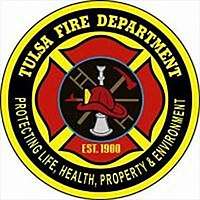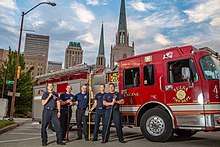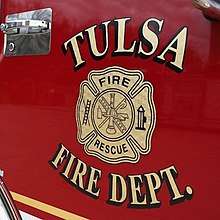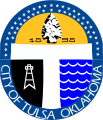Tulsa Fire Department
The Tulsa Fire Department was founded as a volunteer fire department on June 6, 1900, following a fire that broke out in Downtown Tulsa, Oklahoma in 1897.[1] The Tulsa Fire Department headquarters are located at 1760 Newblock Park Drive. The department celebrated its 120th anniversary in June 2020.
 | |
| Operational area | |
|---|---|
| Country | United States |
| State | Oklahoma |
| City | Tulsa |
| Address | 1760 Newblock Park Dr |
| Agency overview | |
| Established | June 6, 1900 |
| Annual calls | 57,000 |
| Annual budget | US$70.3 million |
| Fire chief | Michael Baker |
| Facilities and equipment | |
| Stations | 30 |
| Ambulances | Tulsa Metropolitan Area is worked EMSA |
| Website | |
| Official website | |
Beginning volunteer fire department (1900–1905)
On June 6, 1900, the Tulsa Volunteer Fire Department was officially founded and R. C. Alder was elected Fire chief for the city of Tulsa. In 1901, The Fire Department received its first alarm and responded to deployed hoses and water more effectively than ever before. The city council decided to pay for a chemical truck and start paying them for their response. The Chemical truck was named "Old Soda Fountain" and saved multiple buildings while in service. In early 1905, Chief Alder was sent to Kansas City to choose some recruits and a horse team, this started the first paid Fire Department.
Chiefs


R. C. Alder (1900–22)
When the Electric call boxes started appearing around Tulsa it allowed the Tulsa Fire Department to respond more efficiently and frequently to calls. In February 1906, the Tulsa Fire Department was called the most perfect Department in the country. The head of the rating bureau, Mr. Ingalls said if all the Fire Departments in America followed off of Tulsa the number of fire losses would be decreased by 50% nationwide.
On March 19, 1906, The Electrical inspector and Chief Alder Activated alarm box #39 at 5th & Cheyenne, and even though it was supper relief time 2 men responded in 1 minute and 20 seconds. The Tulsa Fire Department would receive their 1st motorized vehicle in 1907, and when chief Alder requested another motorized vehicle the request was denied because they thought that horse-drawn wagons could never be replaced. In 1908, the Tulsa Fire Department received its 1st aerial ladder truck, a horse team, and a 75-foot aerial ladder for $5,000. By October 1, 1913, everything in Tulsa Fire Department was motorized. The Tulsa Fire Department was the first Fire department west of the Mississippi River to be completely motorized.
On October 24, 1917, two firefighters, Ross Shepard and Ben Hanes were killed while fighting a fire at the Mayo Building from falling through a stairwell. In 1919, the men had 84 hour work weeks divided into two shifts.
Wesley Bush (1922–26)
While chief Wesley Bush was chief, Tulsa Fire Department received 3 new Seagrave Fire Apparatus pumper trucks in 1924. The department had 13 companies and 122 men on the payroll in 1924. On July 1, 1926, the end of the fiscal year showed that the Tulsa Fire Department had responded to 1,091 alarms. Later that year Bush stepped down from his position as fire chief.
R. E. Pitts (1926–33)
The NFBU rated Tulsa Fire Department as one of the best in the nation in 1927. The Department ranked among the best despite being undermanned and inadequately equipped. On April 3, 1928, the firemen submitted a "petition NO. 2" to raise the salary from $0.42 an hour to $0.56 per hour. In 1931 each man signed a contract saying they would pay the survivors of an active firefighter in the event they died on or off the job. In 1931 the Fire Department had 161 men, 12 pump trucks, 4 ladders, and 3 hose carts. Chief R. E. Pitts retired on June 28, 1933.
R. W. Granger (1933–40)
Granger started his career with the company on June 1, 1933, as fire chief. "In December of 1935, Chief Granger made up a Drill Evolution Instruction Guide for governing Company Evolutions. It consisted of "Order No. l," which spelled out how the Drill Evolutions would be carried out, and "Evolution No. l," which was to lay a line into the Drill Tower and charge it".[1] Granger enjoyed a "good" 7 years before being replaced by Fire Chief C.C. Jennings, who would serve for 10 years.
C. C. Jennings (1940–50)
In 1940 the Fire Department received 2 1939 Ford sedans for the district chiefs. In 1941, Captain J.C. Warf was thrown from an open cab Seagrave pumper truck during a collision at pine & Rockford. Captain Warf died at the age of 51. The next day at Hillcrest medical center. In 1943, each Tulsa fire truck would receive a 2-way mobile radio. In 1945 the Tulsa Fire Department got its radio station and would be the most well equipped Fire Department in the Midwest. In 1949 Fire Station #16 was opened and equipped with a 1949 500 gallon American La France Pumper. After 30 years of service, Chief Jennings retired from the department, he had been Chief for 10 years.
G. N. Paris (1950–56)
Chief Paris was the Department's sixth Fire Chief and would remain in this position for 6 years. On January 29, 1955, the Department changed to a schedule of 24 hours on 48 hours off. On May 15, 1956, Chief Paris retired after 27 years with the department, his time as Chief was relatively uneventful.
Galaird Sartain (1956–64)
Galaird was put in as chief after Paris had retired two days before his inauguration as chief. "On October 6, 1956, a fire destroyed the downtown Safeway Store. The loss was estimated to be $500,000. The fire broke through the roof, imperiling some thirty homes in the area". this was a pivotal moment at the beginning of his career as chief. In 1958, 4 new Fire Stations were built and put in the city that year. "In 1961, the Tulsa Fire Department received the highest honor ever afforded a Fire Department in Oklahoma". The Tulsa Fire Department was chosen by the NFPA to be included in a training video "Fighting Tank Fires". In 1964, Chief Sartain retired on July 1st after about 8 years with the force. He was preceded by E. S. Hawkins.[2]
E. S. Hawkins (1964–85)
At the beginning of his time as Chief, the Tulsa Fire Department was said to have been worth around $1,117,225. In 1965 the Tulsa Fire Department purchased an aircraft accident truck and station it at Tulsa International Airport as Unit 51. In 1965, a fire at the London Square apartments claimed the lives of a mother and her 3 kids. The fire brought attention to the fact that firewalls weren't being built in multi-dwelling buildings such as the London Square Apartments. A year later in 1966, another fire broke out in the London Square Apartments but the fire was under control quickly and was put out efficiently. The Tulsa Fire Department said it was because a firewall was built. In 1965 Tulsa Fire Department started installing the microwave teletype which would replace underground cables.
On November 22, 1967, R.C. Alder (first fire chief of Tulsa) made his last run at the age of 90 after his death: his flag-covered casket was taken to Rose Hill Park on Engine #4. In 1968, Tulsa firefighters voted to raise the retirement fund to $3,500. Firefighters were required to use full protective clothing and use the SCBA in 1978. T.R. Coatney suffered a heart attack and died at station 11 on June 29, 1978, his death was considered a Line of Duty Death. Tulsa Fire Department created a 4 minute response time standard for EMS calls in 1981.
In 1982, members of the Tulsa Fire Department were called to Crutchfield Park to fill a small pool with water for the filming of The Outsiders. The Fire Department also helped wet down streets for night filming. In 1982, Dwight Wilson of Station 19 was awarded the Certificate of Merit by the American Red Cross for resuscitating a 15-year-old boy who was exposed to smoke. Chief Hawkins retired in 1985 after 21 years as the Chief of the fire department.
T. L. Baker (1985–2002)
Chief Baker's time as Chief was relatively uneventful until April 19, 1995, when an explosion at the Alfred P. Murrah Federal Building in Oklahoma City killed 168 people. Multiple rescue crews responded from Tulsa and around the country, this would later be known as the Oklahoma City bombing, and it would be the most deadly terrorist attack in America until the September 11 attack. The budget for Tulsa Fire Department in 1996 was $40.2 million. W.D. Meyers suffered a Heart Attack while returning from an incident in Engine #17, his death was considered Line of Duty Death. Chief Baker retired in 2002 and would be succeeded by C.A. Lacroix.
C. A. Lacroix (2002–12)
Lacroix started his new position in 2002 after former Chief Baker had retired. In 1999, the fire departments had decided to help make a bigger role in the Emergency Medical Service by adding five Advanced Life Supports called E22, E23, E24, E27, E29, and these support systems were put into effect in 2002. On December 7th, 2007 "one of the worst ice storms Tulsa would ever see". The station had received hundreds of calls of power outages, damaged properties, civilian casualties, and the total loss of life at 60. During the 2008–2009 Recession, the department faced some budget cuts and downsizing within the company. Lacroix was the chief who got to experience the good effects of Vision 2025 when it started to happen around that time. Lacroix had been in command for 10 years when he decided to retire in Mid-June of 2012.
R. D. Driskell (2012–2020)
Ray Driskell was chosen to be the next chief of the fire department on May 2, 2012, by former Tulsa Mayor Dewey Bartlett.[3] Driskell was employed with the position in late June of 2012. In Driskell's term, he experienced the mobile rise of technology within the company. "Former Fire Chief E. Stanley Hawkins passed away in July 2013 at the age of 92 years. Chief Hawkins served the Department for 37 years, of which 21 years were as Chief".
In 2015, Captain Greta Hurt was promoted to District Chief. She is the first to achieve that accomplishment and being the first female firefighter of the department. "Twenty-three people were hospitalized in October 2015, after a rash of K2 poisonings hit Tulsa. Many were patrons of the Iron Gate Soup kitchen downtown". Driskell was disciplined by Bynum in 2017 after the local firefighters union issued a vote of no-confidence against him stemming from a firefighter’s complaint. After 35 years with the department and serving a little less than 8 years as chief, Driskell decided to retire from his position. Current Tulsa Mayor G. T. Bynum had appointed Deputy Fire Chief Scott Clark as interim chief until the new chief was selected.[4][5][6][7]
Michael Baker (2020–present)
Michael Baker started his term as chief of the fire department on June 16, 2020, by Mayor Bynum.[8] Chief Baker has served more than 30 years in public safety, 25 of those with the Tulsa Fire Department. He’s played a key role in the development of TFD’s Community Assistance, Referral, and Education Services (CARES) program.[9]
See Also
References
- "History of Tulsa Fire Department" (PDF).
- https://www.cityoftulsa.org/media/3311/tfdhistory2-2017.pdf
- https://www.tulsaworld.com/news/crimewatch/tulsa-s-th-fire-chief-sworn-into-office/article_2a5b8065-3001-50bb-a45c-668bfe7d2a94.html
- https://www.tulsaworld.com/news/local/government-and-politics/tulsa-fire-chief-ray-driskell-retiring-after-35-years-on-job-8-years-as-chief/article_49806f9c-3290-5606-80f7-a22d5c28450f.html
- https://www.cityoftulsa.org/press-room/fire-chief-ray-driskell-announces-retirement/
- https://www.news9.com/story/5ea39280d795682ab682e335/tulsa-fire-chief-ray-driskell-announced-retirement
- http://tulsabeacon.com/fire-chief-ray-driskell-retires/
- https://www.newson6.com/story/5ee7daeaa7910a5146463337/mayor-bynum-selects-michael-baker-as-new-tulsa-fire-chief-
- https://www.newson6.com/story/5ee7daeaa7910a5146463337/mayor-bynum-selects-michael-baker-as-new-tulsa-fire-chief-

